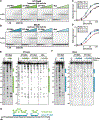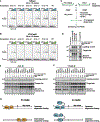Conserved and divergent DNA recognition specificities and functions of R2 retrotransposon N-terminal domains
- PMID: 38753487
- PMCID: PMC11204384
- DOI: 10.1016/j.celrep.2024.114239
Conserved and divergent DNA recognition specificities and functions of R2 retrotransposon N-terminal domains
Abstract
R2 non-long terminal repeat (non-LTR) retrotransposons are among the most extensively distributed mobile genetic elements in multicellular eukaryotes and show promise for applications in transgene supplementation of the human genome. They insert new gene copies into a conserved site in 28S ribosomal DNA with exquisite specificity. R2 clades are defined by the number of zinc fingers (ZFs) at the N terminus of the retrotransposon-encoded protein, postulated to additively confer DNA site specificity. Here, we illuminate general principles of DNA recognition by R2 N-terminal domains across and between clades, with extensive, specific recognition requiring only one or two compact domains. DNA-binding and protection assays demonstrate broadly shared as well as clade-specific DNA interactions. Gene insertion assays in cells identify the N-terminal domains sufficient for target-site insertion and reveal roles in second-strand cleavage or synthesis for clade-specific ZFs. Our results have implications for understanding evolutionary diversification of non-LTR retrotransposon insertion mechanisms and the design of retrotransposon-based gene therapies.
Keywords: CP: Molecular biology; DNA-binding specificity; Myb domain; R2 retrotransposon; gene insertion; gene therapy; genome engineering; non-LTR retrotransposon; protein-DNA interaction; zinc finger.
Copyright © 2024 The Author(s). Published by Elsevier Inc. All rights reserved.
Conflict of interest statement
Declaration of interests B.V.T. and K.C. are listed inventors on patent applications filed by University of California, Berkeley, related to the transgene insertion technology platform. B.V.T. and K.C. have equity options in Addition Therapeutics, which licensed the University of California, Berkeley technology. K.C. is a consultant and board member of Addition Therapeutics but does not receive personal compensation for these roles.
Figures







Similar articles
-
Structure and sequence at an RNA template 5' end influence insertion of transgenes by an R2 retrotransposon protein.RNA. 2024 Aug 16;30(9):1227-1245. doi: 10.1261/rna.080031.124. RNA. 2024. PMID: 38960642 Free PMC article.
-
Identification of rDNA-specific non-LTR retrotransposons in Cnidaria.Mol Biol Evol. 2006 Oct;23(10):1984-93. doi: 10.1093/molbev/msl067. Epub 2006 Jul 26. Mol Biol Evol. 2006. PMID: 16870681
-
Targeting novel sites: The N-terminal DNA binding domain of non-LTR retrotransposons is an adaptable module that is implicated in changing site specificities.Mob Genet Elements. 2011 Sep;1(3):169-178. doi: 10.4161/mge.1.3.18453. Epub 2011 Sep 1. Mob Genet Elements. 2011. PMID: 22479684 Free PMC article.
-
Identification of the endonuclease domain encoded by R2 and other site-specific, non-long terminal repeat retrotransposable elements.Proc Natl Acad Sci U S A. 1999 Jul 6;96(14):7847-52. doi: 10.1073/pnas.96.14.7847. Proc Natl Acad Sci U S A. 1999. PMID: 10393910 Free PMC article.
-
Structural and biochemical studies of mobile retrotransposon proteins in action.Curr Opin Struct Biol. 2025 Jun;92:103053. doi: 10.1016/j.sbi.2025.103053. Epub 2025 May 6. Curr Opin Struct Biol. 2025. PMID: 40334519 Review.
Cited by
-
Biology and utilization of R2 retrotransposons.RNA Biol. 2025 Dec;22(1):1-8. doi: 10.1080/15476286.2025.2521890. Epub 2025 Jun 25. RNA Biol. 2025. PMID: 40566873 Free PMC article. Review.
-
Lineage-Specific Evolution, Structural Diversity, and Activity of R2 Retrotransposons in Animals.bioRxiv [Preprint]. 2025 May 9:2025.05.05.652312. doi: 10.1101/2025.05.05.652312. bioRxiv. 2025. PMID: 40654615 Free PMC article. Preprint.
-
Structure and sequence at an RNA template 5' end influence insertion of transgenes by an R2 retrotransposon protein.RNA. 2024 Aug 16;30(9):1227-1245. doi: 10.1261/rna.080031.124. RNA. 2024. PMID: 38960642 Free PMC article.
-
Structures of vertebrate R2 retrotransposon complexes during target-primed reverse transcription and after second strand nicking.bioRxiv [Preprint]. 2024 Nov 20:2024.11.11.623112. doi: 10.1101/2024.11.11.623112. bioRxiv. 2024. Update in: Sci Adv. 2025 Jun 20;11(25):eadu5533. doi: 10.1126/sciadv.adu5533. PMID: 39605677 Free PMC article. Updated. Preprint.
-
Structures of vertebrate R2 retrotransposon complexes during target-primed reverse transcription and after second-strand nicking.Sci Adv. 2025 Jun 20;11(25):eadu5533. doi: 10.1126/sciadv.adu5533. Epub 2025 Jun 20. Sci Adv. 2025. PMID: 40540573 Free PMC article.
References
Publication types
MeSH terms
Substances
Grants and funding
LinkOut - more resources
Full Text Sources
Miscellaneous

